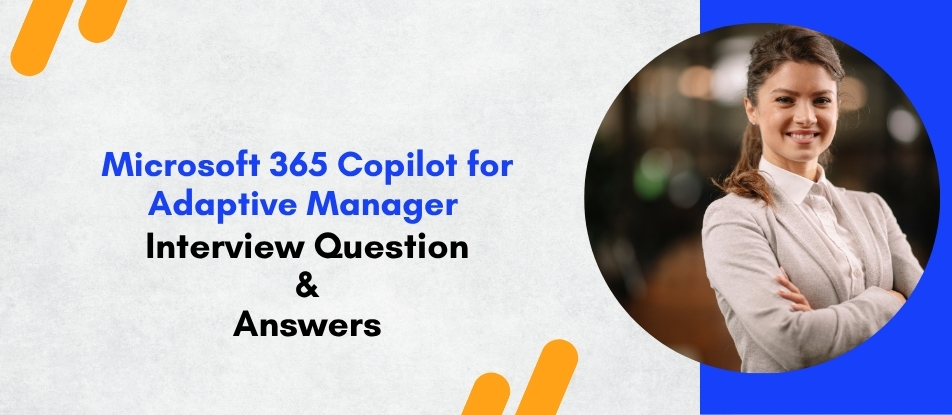
The Microsoft 365 Copilot for Adaptive Manager training is designed to help managers harness the power of AI within Microsoft 365 to boost productivity and decision-making. Learners explore how Copilot streamlines reporting, communication, and performance analysis through intelligent automation. The course emphasizes adaptive leadership, enabling participants to integrate AI insights for agile project management, data storytelling, and team collaboration. Ideal for forward-thinking professionals, it equips managers to transform operations and lead confidently in today’s dynamic, technology-driven workplace.
Microsoft 365 Copilot for Adaptive Manager Training Interview Questions Answers - For Intermediate
1. How does Microsoft 365 Copilot help managers automate task delegation?
Copilot assists in task delegation by analyzing meeting notes, project plans, and conversations to identify action items and suggest appropriate assignees based on workload, role, or expertise. It can automatically create tasks in Planner or To Do and update timelines as progress is made. This ensures that managers spend less time micromanaging and more time focusing on strategic objectives.
2. How does Copilot contribute to better time management for Adaptive Managers?
Copilot analyzes calendar data and communication patterns to recommend schedule optimizations, identify time leaks, and suggest focus blocks. It can automatically prioritize tasks or reschedule meetings to reduce conflicts. This enables managers to structure their day efficiently and maintain a healthy balance between operational duties and leadership responsibilities.
3. How can Copilot enhance data-driven culture in organizations?
Copilot democratizes data access by allowing employees and managers to interact with data through natural language queries instead of complex formulas or dashboards. This accessibility encourages decision-making based on facts rather than assumptions. Over time, it fosters a culture where insights are continuously leveraged to improve business outcomes.
4. How does Copilot support change management initiatives?
During organizational transformation, Copilot provides managers with visibility into communication sentiment, task completion rates, and employee feedback. It can summarize survey data, generate progress reports, and suggest targeted engagement messages. These features help leaders monitor the effectiveness of change initiatives and maintain alignment across teams.
5. How does Copilot assist in managing hybrid or remote teams?
In hybrid environments, Copilot consolidates communication, meeting insights, and shared documents from Microsoft 365 tools. It helps managers stay connected with remote employees by summarizing discussions, tracking deliverables, and identifying engagement gaps. This ensures distributed teams remain cohesive and performance-driven regardless of location.
6. What is the significance of Copilot’s integration with Outlook for managers?
Copilot enhances Outlook by generating concise email drafts, summarizing long threads, and suggesting replies based on context and tone. It also flags urgent messages or pending approvals. This improves responsiveness and reduces inbox overload, allowing managers to focus on high-impact communication rather than routine correspondence.
7. How does Copilot contribute to organizational knowledge management?
Copilot organizes, summarizes, and retrieves relevant content from SharePoint, OneNote, and Teams channels. It helps managers locate the right documents and reference materials instantly using semantic understanding rather than keywords. This accelerates knowledge sharing and ensures that information is easily accessible to all team members when needed.
8. How does Copilot improve collaboration between cross-functional teams?
Copilot identifies dependencies and shared objectives across departments, helping managers align teams more effectively. It summarizes joint meeting discussions, merges data insights, and highlights overlapping deliverables. This cross-functional intelligence promotes transparency, reduces duplication of effort, and enhances collaboration toward common business goals.
9. How does Copilot help in performance tracking and KPI monitoring?
Through integrations with Excel, Power BI, and Viva Insights, Copilot enables managers to monitor key performance indicators in real time. It can generate automated performance summaries, highlight deviations, and recommend corrective actions. This continuous monitoring empowers managers to make timely interventions for achieving departmental goals.
10. How can Copilot assist in improving reporting accuracy?
Copilot minimizes manual data entry and human errors by pulling information directly from connected systems like Dynamics 365, SharePoint, and Teams. It cross-checks inconsistencies, standardizes report formatting, and ensures alignment with the latest data. This automation leads to consistent, reliable, and up-to-date managerial reports.
11. How does Copilot personalize insights for individual managers?
By learning from a manager’s communication style, recurring tasks, and decision patterns, Copilot personalizes recommendations and insights. It adapts to specific goals, team structure, and business needs, offering tailored suggestions rather than generic outputs. This personalization makes Copilot a more intuitive and context-aware assistant.
12. How does Copilot enhance leadership communication?
Copilot assists leaders by drafting persuasive presentations, executive summaries, and briefing notes. It ensures tone consistency and professional clarity in internal and external communication. By summarizing stakeholder feedback and tracking sentiment trends, it also helps leaders address concerns more effectively, thereby improving organizational transparency and trust.
13. What are the advantages of Copilot’s integration with Microsoft Loop?
Microsoft Loop allows dynamic collaboration through shared workspaces, and Copilot enhances this by summarizing progress, suggesting updates, and automating documentation. It keeps all stakeholders aligned through real-time updates and context-aware prompts. This integration bridges collaboration and execution, ensuring continuous information flow across teams.
14. How can Copilot support employee learning and development initiatives?
Copilot can recommend personalized training materials, summarize learning progress from LinkedIn Learning or Viva Learning, and highlight areas requiring improvement. It assists managers in identifying skill gaps within teams, helping to create targeted development plans. This makes performance management more proactive and continuous rather than reactive.
15. What steps can managers take to maximize the effectiveness of Microsoft 365 Copilot?
Managers should ensure seamless data integration across all Microsoft 365 apps, provide user training, and establish clear guidelines for AI usage. Encouraging feedback loops, monitoring Copilot’s output accuracy, and aligning its insights with business goals are crucial for maximizing ROI. The more structured and secure the organization’s data ecosystem, the more value Copilot delivers in managerial contexts.
Microsoft 365 Copilot for Adaptive Manager Training Interview Questions Answers - For Advanced
1. How does Microsoft 365 Copilot enable adaptive performance management in dynamic business environments?
Microsoft 365 Copilot enables adaptive performance management by continuously collecting and interpreting data from multiple Microsoft 365 applications—such as Teams, Outlook, Excel, and Viva Insights—to deliver real-time performance analytics. It helps managers track progress against KPIs, identify areas of underperformance, and receive recommendations on corrective actions. For instance, if a project shows declining task completion rates, Copilot may suggest redistributing workloads or revising timelines. Its AI-driven analysis of engagement data ensures that managerial feedback and decision-making remain evidence-based, not subjective. This dynamic loop of monitoring, evaluation, and action empowers managers to sustain agility even when market conditions shift rapidly.
2. How does Copilot redefine the role of data storytelling in managerial communication?
Copilot transforms data storytelling by bridging analytical insights with narrative intelligence. It can convert raw numerical data from Excel or Power BI into compelling stories that include trends, comparisons, and contextual explanations. Adaptive Managers can request summaries such as “Explain Q3 sales drop in three key regions,” and Copilot responds with structured, visually supported narratives. This contextual storytelling enhances the manager’s ability to communicate complex insights to non-technical stakeholders. The result is better alignment between analytics and leadership vision, enabling more persuasive, data-informed communication across organizational levels.
3. How does Microsoft 365 Copilot enhance the decision ecosystem through contextual intelligence?
Copilot’s contextual intelligence stems from its access to the Microsoft Graph, which aggregates signals from user interactions, shared files, meetings, and communication patterns. This holistic context allows Copilot to deliver nuanced recommendations rather than isolated insights. For example, when drafting a proposal, it can suggest related documents or highlight key contributors based on previous collaboration data. For managers, this means better situational awareness, as Copilot understands organizational context—who’s involved, what’s pending, and where priorities lie. This networked intelligence transforms decisions from reactive actions to informed, connected strategies grounded in the enterprise’s real-time operational pulse.
4. How does Copilot integrate with Microsoft Viva to promote holistic employee well-being and productivity?
When integrated with Microsoft Viva, Copilot becomes an enabler of people analytics and well-being. It aggregates data from Viva Insights to monitor focus time, collaboration hours, and potential burnout signals. Managers can use these insights to design balanced workloads and promote well-being-oriented work cultures. For instance, if employees consistently work late, Copilot can flag the trend and suggest workload redistribution. Furthermore, it provides managers with summaries of engagement trends, learning progress, and morale indicators, ensuring leadership decisions support both productivity and employee satisfaction—a balance critical for adaptive organizations.
5. How does Copilot accelerate cross-departmental collaboration in complex organizations?
Copilot serves as a unifying intelligence layer across departments by identifying overlapping objectives, dependencies, and communication threads. It automatically consolidates updates from multiple Teams channels or SharePoint folders and provides synthesized insights relevant to multi-departmental projects. For example, in a company with concurrent marketing and product launches, Copilot can summarize joint discussions and highlight potential conflicts in timelines or budgets. This visibility promotes transparency and minimizes duplication of efforts. Adaptive Managers thus gain a shared, real-time understanding of interdepartmental progress, fostering smoother collaboration and faster strategic execution.
6. What impact does Copilot have on digital dexterity and learning agility among managers?
By reducing the technical barrier to data analysis and report generation, Copilot enhances digital dexterity across leadership roles. Managers who previously relied on analysts for data interpretation can now interact directly with data through natural language prompts. This democratization of analytics encourages self-sufficiency and cultivates a learning mindset. Over time, managers develop agility in adapting to emerging digital tools and workflows. Furthermore, Copilot’s adaptive feedback loop—where it refines responses based on user behavior—encourages continuous learning, helping managers evolve alongside technological advancements and industry demands.
7. How does Copilot contribute to creating an adaptive feedback culture within organizations?
Copilot facilitates feedback cultures by analyzing communication sentiment across Teams, Outlook, and Viva. It identifies engagement trends, detects communication bottlenecks, and suggests constructive responses. For instance, if recurring themes of delay or confusion appear in project threads, Copilot can summarize concerns and propose clarifying actions. Managers can also use it to generate data-backed performance discussions, ensuring feedback is objective and balanced. Over time, this AI-supported transparency builds trust and psychological safety, enabling a more open, continuous exchange of ideas—key characteristics of adaptive, high-performing organizations.
8. How does Copilot influence adaptive budgeting and financial forecasting?
Copilot transforms budgeting by integrating with Excel, Dynamics 365, and Power BI to provide real-time financial insights and simulations. Managers can request, in plain language, forecasts such as “Project next quarter’s operational cost if marketing spend increases by 10%.” The system generates adaptive models that dynamically adjust as new data flows in. It detects spending anomalies and recommends corrective measures, such as reallocating budgets or reducing discretionary expenses. This AI-enhanced financial intelligence allows organizations to remain financially agile and make informed investment decisions in rapidly changing markets.
9. How does Microsoft 365 Copilot align with the principles of human-centered leadership?
Copilot complements human-centered leadership by taking over repetitive cognitive load and allowing managers to focus on empathy, mentorship, and innovation. It provides personalized communication insights, enabling managers to understand team morale and engagement more deeply. For example, through sentiment analysis and meeting behavior tracking, Copilot helps identify disengaged employees or unbalanced workloads. Managers can use this intelligence to tailor their communication and support strategies. In essence, Copilot augments—not replaces—the human touch in leadership by freeing cognitive bandwidth for emotionally intelligent decision-making.
10. How does Copilot advance knowledge automation and continuous documentation?
Knowledge loss remains a major challenge in dynamic organizations. Copilot combats this by automatically summarizing meetings, extracting decisions, and storing key takeaways in SharePoint or OneNote. It creates a searchable trail of knowledge that can be retrieved at any time, ensuring that institutional memory remains intact. Managers benefit from having contextual archives of every major discussion, making onboarding and project transitions seamless. This continuous knowledge automation minimizes dependence on manual documentation and preserves organizational intelligence as a living, evolving asset.
11. How does Copilot enhance governance, compliance, and audit readiness for managers?
Through integration with Microsoft Purview and Compliance Manager, Copilot helps enforce governance and regulatory compliance. It flags policy violations in documents or emails, provides summaries of compliance risks, and suggests remediation steps. For adaptive managers working in regulated sectors such as finance or healthcare, this functionality ensures proactive compliance management without slowing operations. Copilot can also automate the creation of audit-ready reports, ensuring traceability and accountability. This reduces administrative burden and minimizes risk exposure, positioning AI as both a governance enabler and a compliance guardian.
12. How does Microsoft 365 Copilot strengthen crisis management and rapid response mechanisms?
During crises, Copilot serves as a real-time coordination hub that aggregates information from Teams, Outlook, and SharePoint. It identifies relevant stakeholders, compiles situation updates, and drafts immediate response plans. By analyzing communication traffic, Copilot detects emerging concerns and prioritizes critical tasks. Its ability to summarize ongoing events and distribute verified updates prevents misinformation and ensures clarity. This intelligence-driven orchestration enables managers to react quickly and maintain order, transforming crisis management from reactive firefighting into structured, proactive response strategies.
13. How does Copilot enable cognitive diversity and inclusive decision-making?
Copilot supports inclusion by ensuring all voices are represented in data-driven decisions. It analyzes participation patterns in Teams and meetings to highlight underrepresented contributors or ideas. Managers receive summaries identifying whose inputs are being overlooked and can take corrective measures to ensure diversity of thought. Furthermore, Copilot can translate or simplify complex communication for multilingual teams, enabling equal access to discussions and knowledge. This inclusivity fosters cognitive diversity, leading to more creative solutions and equitable workplace engagement.
14. What advanced data ethics considerations should Adaptive Managers maintain while deploying Copilot?
Advanced AI deployment comes with ethical responsibilities. Adaptive Managers must ensure Copilot is used within the boundaries of data minimization, informed consent, and transparency. Employees should know when and how their data is analyzed. Managers must prevent algorithmic bias by regularly auditing AI outputs for fairness. Furthermore, sensitive communication data should be protected through strict access control and encryption. Microsoft’s enterprise-grade compliance framework provides a secure foundation, but ethical leadership ensures that these standards are implemented with accountability and integrity across managerial decisions.
15. How does Copilot’s evolving architecture contribute to long-term enterprise adaptability?
Copilot’s architecture is designed for scalability, leveraging Microsoft’s cloud-native foundation and continuous learning models. Its modular integration with third-party APIs and evolving prompt engineering capabilities allows it to adapt to industry-specific workflows. As organizational data environments grow more complex, Copilot’s interoperability ensures seamless orchestration across collaboration, analytics, and automation tools. Over time, it learns from organizational behavior to refine recommendations, transforming from a reactive assistant into a proactive co-strategist. This evolutionary capability positions Copilot as an enduring enabler of enterprise adaptability in the digital era.
Course Schedule
| Dec, 2025 | Weekdays | Mon-Fri | Enquire Now |
| Weekend | Sat-Sun | Enquire Now | |
| Jan, 2026 | Weekdays | Mon-Fri | Enquire Now |
| Weekend | Sat-Sun | Enquire Now |
Related Courses
Related Articles
- SAP BRIM Online Course: A Course Overview
- Is there any functional difference between SAP BI vs SAP Power BI?
- Why AutoCAD P&ID Essentials Is Crucial for Process Safety and Compliance
- How Snowflake Administering Training Can Boost Your Career?
- Kronos Workforce (UKG) Dimensions: A Complete Guide for HR and Business Leaders
Related Interview
- AVEVA P&ID User Interview Questions Answers
- ServiceNow ESM Training Interview Questions Answers
- AWS Certified Cloud Practitioner (AWS Cloud Practitioner) Interview Questions Answers
- Workday Advanced Reporting Training Interview Questions Answers
- BIM with Revit for Architects Training Interview Questions Answers
Related FAQ's
- Instructor-led Live Online Interactive Training
- Project Based Customized Learning
- Fast Track Training Program
- Self-paced learning
- In one-on-one training, you have the flexibility to choose the days, timings, and duration according to your preferences.
- We create a personalized training calendar based on your chosen schedule.
- Complete Live Online Interactive Training of the Course
- After Training Recorded Videos
- Session-wise Learning Material and notes for lifetime
- Practical & Assignments exercises
- Global Course Completion Certificate
- 24x7 after Training Support

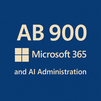
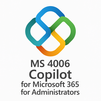
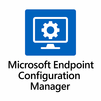
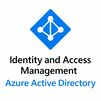





 Join our Live Instructor-Led online classes delivered by industry experts
Join our Live Instructor-Led online classes delivered by industry experts